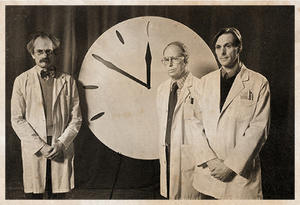Nuclear mattersScientists cautiously optimistic as Doomsday clock reset
The minute hand of the Bulletin of Atomic Scientists’ Doomsday clock was moved back one minute – to seven minutes to midnight – to indicate a slight improvement in the world’s nuclear weapons situation; midnight on the clock signifies the apocalypse, and the minute hand symbolizes the countdown to disaster

Doomsday clock, circa 1947 // Source: farm4.static.flickr.
The minute hand of the Doomsday clock was moved back slightly yesterday, indicating the world has inched away from nuclear or environmental catastrophe, but stressing it was not out danger. “It is six minutes to midnight,” the Bulletin of Atomic Scientists, which created the Doomsday clock in 1947, said in a statement read out as the clock’s countdown to midnight was nudged back by one minute from where it has been since 2007. “For the first time since atomic bombs were dropped in 1945, leaders of nuclear weapons states are cooperating to vastly reduce their arsenals and secure all nuclear bomb-making material,” the statement by the panel of international scientists, including nineteen Nobel laureates, said.
“For the first time ever, industrialized and developing countries alike are pledging to limit climate-changing gas emissions that could render our planet nearly uninhabitable. These unprecedented steps are signs of a growing political will to tackle the two gravest threats to civilization — the terror of nuclear weapons and runaway climate change,” it said.
Grist reports that since it was created by scientists who helped to develop the world’s first atomic weapons, the Doomsday clock has come to be seen as a barometer of what progress, if any, the world has made in moving away from the risk of nuclear, climate-caused or bio-warfare catastrophe.
Midnight on the clock signifies the apocalypse, and the minute hand symbolizes the countdown to disaster.
The last time the minute hand of the clock was moved was in 2007, when it was bumped two minutes closer to midnight.
In resetting the clock this year, the scientists said they were encouraged by recent developments, but had put back the clock by only one minute to show they were “mindful that the clock is ticking,” said BAS’s Lawrence Krauss. “We moved it back by just one minute and what that means is that there’s great potential for it to move again, in either direction,” said Krauss, a physicist and co-chair of BAS’s board of sponsors.
“We have a unique opportunity right now to begin to free ourselves from the terror of nuclear weapons and to slow drastic changes to our shared global environment. We must take advantage of that opportunity now,” said Krauss, calling on world leaders, scientists and ordinary people to work together to make the world safer. Let’s not blow it,” he urged.
The Bulletin of Atomic Scientists was founded in 1945 by scientists from the University of Chicago who had helped to develop the first atomic weapons.
